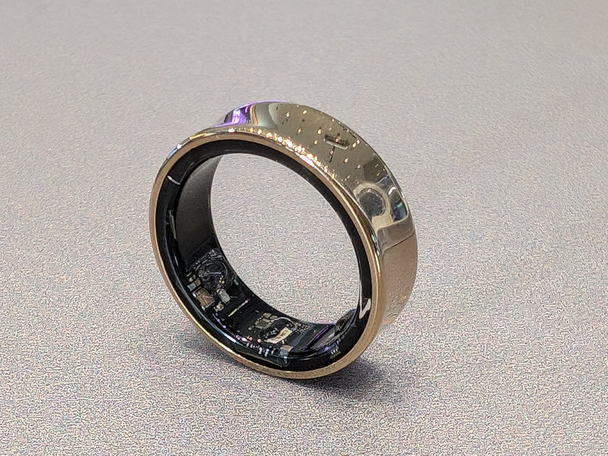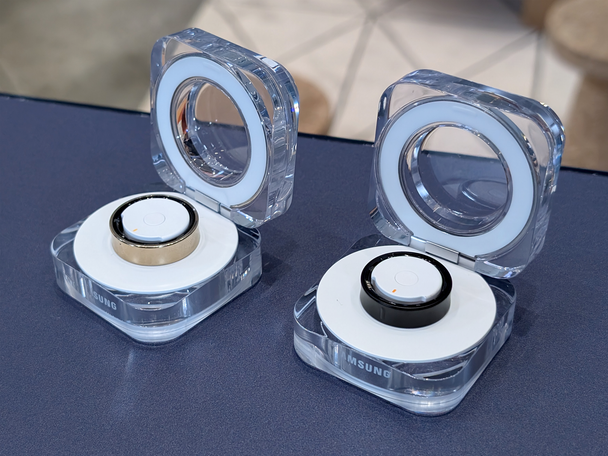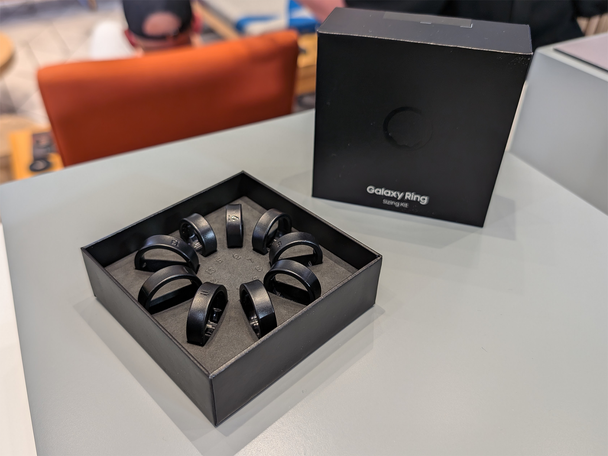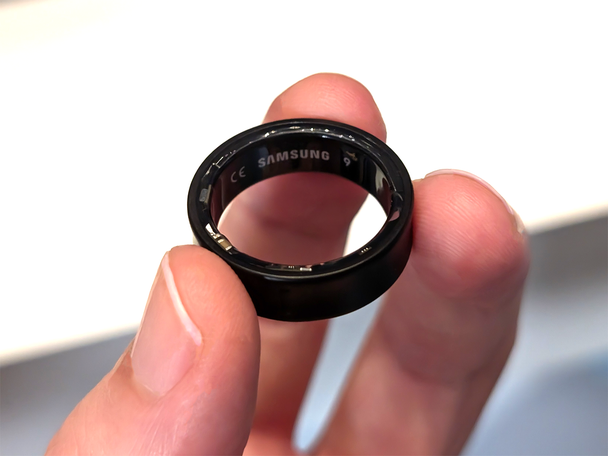Price

Unveiled during Galaxy Unpacked in July 2024, the Galaxy ring costs £399. That’s pretty expensive – it’s a fair chunk more than the Oura ring gen 3 heritage model (£299, Ouraring.com) and still slightly pricier than the new Oura Ring gen 4, (£349, Amazon.co.uk).
However, unlike Oura, Samsung doesn’t charge a monthly subscription fee. You pay once and get access to everything, including sleep metrics, recovery scores and health insights. In contrast, Oura’s features remain locked behind a £5.99 monthly subscription – without it, you’re limited to surface-level data.
Design

One of the Galaxy ring’s biggest strengths is its design. Made from durable titanium, it comes in three finishes – black, gold and silver – and features a concave outer edge that helps protect it from scratches and knocks. It’s water-resistant and can handle being taken for a swim, though you might want to take it off during a weightlifting session.
It’s lightweight too – slightly more so than the Oura – and comfortable to wear all day, despite the slight bump of the sensors against the skin.
Like other smart rings on the market, there are lots of different ring sizes to choose from, and you can get a sizing kit to figure out the best one for you. Samsung recommends wearing the plastic test ring for 24 hours to find the best fit for your finger as you sleep and go about your day.
Available in US ring sizes 5 to 13, I was between a size 8 and 9 on the Galaxy ring, and am a size 8 on the Oura ring, so the sizes are fairly similar. Samsung says the ideal finger for the ring is the index finger, so make sure to fit the ring based on your index finger size.

The real game-changing design choice, however, is that the Galaxy ring sits inside an earbuds-like charging case with a lid. It looks a bit like the old Samsung Galaxy Buds clamshell case, with the lid flipping up like a ring jewellery box. This is just a much more convenient way of charging and storing your ring, and it’s a huge improvement on anything I’ve seen before.
The Oura ring sits on a cradle, which I find is easy to lose and tip over onto the floor, while the Circular ring had a very fiddly charging cable attachment in my tests. The Galaxy ring case, however, is the most seamless way of charging a smart ring I’ve seen yet. Plus, it can be charged wirelessly or through USB-C. While it’s not the most durable – the ring fell out of the plastic case when dropped on the floor – Samsung doesn’t expect you to keep the case in your pocket like a pair of earbuds.
The ring’s primarily going to be on your finger unless you’re charging it, which you shouldn’t need to do too frequently. You get roughly seven days of use out of a single charge – it’s a great storage solution.
Health tracking and features
Unlike the Oura ring, however, the Galaxy ring isn’t designed to replace your smartwatch – it’s meant to complement it. It tracks your heart rate, steps, stress levels, sleep and menstrual cycles, crunching all the data into a daily energy score (previously known as a vitality score). You’ll also find insights and tips in the Samsung Health app, though they can be fairly generic. If you’re stressed, for example, the app will suggest breathing exercises – not exactly groundbreaking, but useful in a passive kind of way.
Samsung also includes a sleep coaching programme, which pulls together your sleep data and vitals to generate a score and provide tailored suggestions on how to improve your sleep. The ring uses blood oxygen levels, skin temperature, respiration and movement to build up a picture of your sleep cycles and stages. I think this is one of its strongest features.
You also get inactivity alerts if you’ve been sitting too long and live heart rate readings in the app. It’s handy during a gym session if you’ve propped your phone up on a rower. However, accessing that data is far less convenient than glancing at a watch screen. There’s also a skin temperature sensor to help track menstrual cycles and fertility windows, plus inactive alerts that ping your Galaxy phone when you’ve been sedentary for too long.
It offers automatic activity detection for walking and running, but it didn’t track other workouts – such as cycling, elliptical sessions and yoga – unless I started them manually in the Health app. Even then, cadence tracking during runs wasn’t the most accurate. Keep your smartwatch on if you’re training for a 10K.
The gesture controls are another clever touch – double pinch your thumb and index finger to snooze an alarm or remotely take a photo. It’s a neat addition that feels futuristic without being gimmicky.

While the Galaxy ring has closed the gap in many ways, Oura’s gen 4 ring still edges ahead in some areas. It features improved heart-rate accuracy, better automatic workout detection and more advanced cycle tracking. Oura’s AI Advisor also feels more personalised and useful than Samsung’s current wellness tips, which still feel vague. But again, you’ll need to pay monthly for access to those features.
Compatibility and performance
There’s a big catch, though. While the Galaxy ring technically works with all Android phones running Android 11 or later, you’ll need a Samsung Galaxy phone to unlock its full potential. Features like heart-rate delegation to a Galaxy Watch and tight ecosystem syncing make the experience feel seamless if you already use Samsung tech. If you’ve got a Pixel or other Android phone, expect a pared-back experience. Onn an iPhone? You’re out of luck – the Galaxy ring won’t work at all.
The battery life is excellent – my tests found that the ring can last up to seven days on a single charge. All your data syncs with the Samsung Health app, which is slick and well-designed, though a little dense to navigate at times. Samsung’s AI-powered wellness tips could be more tailored – especially when compared to Oura’s increasingly sophisticated guidance- but there’s potential for this to improve with future updates.
The Galaxy ring is also compatible with Samsung’s Find My service, so if you lose it somewhere and someone with a Galaxy phone is in the vicinity, you’ll be able to find its location easily enough.











